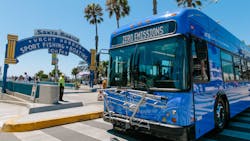Big Blue Bus welcomes first zero-emissions vehicle to fleet
Big Blue Bus (BBB), which serves Santa Monica, Calif., and west Los Angeles, held a ribbon-cutting ceremony Aug. 21 to unveil its first battery-electric bus.
The launch of the bus into service isn’t just a key milestone in BBB’s journey toward a zero-emission fleet by 2030, but marks a step toward an enhanced customer experience, as well.
Ed King, director of Transit Services at BBB, pointed to the tagline on the side of the bus, which read “zero emissions for people, place & planet,” and reminded attendees at the ribbon-cutting ceremony that BBB has come a long way in its 91 years of service. As much as the day was about the bus, King explained it was also about people and providing improvements to riders through a smoother, quieter ride and a reduced carbon footprint.
Santa Monica Mayor Gleam Davis told the crowd that one of the best things anyone could do to improve their individual sustainability efforts would be to take a ride on the new bus. The single bus is estimated to eliminate more than 385,700 lbs. of nitrogen oxide (NOx) emissions over its 12-year service life as compared to BBB’s 2004 LNG bus. BBB has reduced its NOx emissions 70 percent in the past three years.
The 40-foot bus, which entered revenue service shortly after the ribbon-cutting ceremony, has six onboard batteries that provide a total capacity of 444kWh. It can be fully charged in under four hours on paired ChargePoint Express 250 chargers installed at the bus maintenance facility. The bus can hold 75 passengers, 38 seated, and the onboard passenger amenities include easy to clean seats, Wi-Fi, a passenger awareness monitor, silver LED destinations signs, slip-resistant flooring, the EZ Stop System and a Q-POD Wheelchair Restraint System.
BBB Transit Maintenance Manager Getty Modica said the bus should be in service for 150 miles per charge and it will begin service on routes that are just shy of that mark.
“We have to get accustomed to looking at electricity as a fuel and how do we quantify that to make sure we are getting the proper kilowatt per mile,” said Modica. “We are starting with baby steps and then we will really put this bus through its paces.”
Modica said BBB used route modeling to prepare for the bus to enter service and will be able to monitor the bus in real time to view all the matrixes inherent to the vehicle, everything from operator behavior to temperature.
“We’ll be able to look at what is going on with this bus from the other end of the country. It’s exciting,” he added.
BBB also took steps to ensure operators and maintenance personnel were prepared for the new member of the fleet. Staff went through basic and advanced electrical knowledge training, a core team went through NFPA 70E training to make sure the high voltage side of safety is covered and Modica explained there was additional training above and beyond the base level to ensure work on the bus can be performed in a safe manner.
BBB worked closely with GILLIG and Cummins to ensure the bus would perform as needed. Modica credits the teams from GILLIG and Cummins for keeping the flow of information between the companies open and transparent during the development process.
BBB’s new bus is also the first bus to be delivered and put into service following GILLIG’s entry into the battery electric bus market. The bus was built at GILLIG’s Livermore, Calif., facility in collaboration with Cummins of Columbus, Ind., who designed and manufactured the electric propulsion system for the bus.
“[BBB’s] standards were high and not always easy, but they were always fair,” said Derek Maunus, president and CEO of GILLIG. “Innovation is the successful transition of technology without sacrificing the mission of transit.”
Cummins Vice President-Electrified Power Julie Furber added, “Innovation is a state of mind. Our work is local, but our mission is global. Thank you, Santa Monica, for being role models moving people and communities forward.”
The city is expected to approve specs for an additional 18 battery electric buses this fall that would be delivered in 2021. Ten of those buses will be funded by a $3 million grant from the California State Transportation Agency through the Transit and Intercity Rail Capital Program.

Mischa Wanek-Libman | Group Editorial Director
Mischa Wanek-Libman is director of communications with Transdev North America. She has more than 20 years of experience working in the transportation industry covering construction projects, engineering challenges, transit and rail operations and best practices.
Wanek-Libman has held top editorial positions at freight rail and public transportation business-to-business publications including as editor-in-chief and editorial director of Mass Transit from 2018-2024. She has been recognized for editorial excellence through her individual work, as well as for collaborative content.
She is an active member of the American Public Transportation Association's Marketing and Communications Committee and served 14 years as a Board Observer on the National Railroad Construction and Maintenance Association (NRC) Board of Directors.
She is a graduate of Drake University in Des Moines, Iowa, where she earned a Bachelor of Arts degree in Journalism and Mass Communication.



